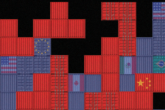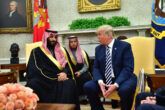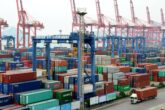January 14, 2021
Sanctions by the Numbers: 2020 Year in Review
Key Takeaways
- Sanctions designations remained high in 2020, with 777 designations compared to 785 in 2019.
- Iran was by far the most prominent target of U.S. sanctions in 2020, with 43 percent of designations targeting Iran-linked individuals and entities—a significant increase from 2019 when Iran-related designations were just under 27 percent of designations.
- There were 90 designations of Chinese entities and individuals in 2020, representing 11.5 percent of total 2020 designations.
- Over 22 percent of 2020 sanctions designations came after the U.S. presidential election in November.
- Delistings also were up significantly in 2020. The Trump administration delisted 212 entities and individuals, more than double the number of delistings in 2019.
During Donald Trump’s administration, the United States significantly increased its use of sanctions, and 2020 was no exception. The total number of new sanctions designations in 2020 was only slightly lower than in 2019, with 777 designations compared to 785 in 2019.
Iran was by far the most prominent target of U.S. sanctions in 2020.
The administration intensified its focus on Iran in 2020, with over 40 percent of 2020 sanctions designations focused on Iran-linked entities and individuals. This number is up from 211 in 2019 to 336 in 2020. China was also a major focus for increased sanctions designations in 2020, with 90 designations of China-linked entities and individuals compared to 23 in 2019. Similarly, Venezuela, another country subject to a Trump administration “maximum pressure” campaign, was a major 2020 sanctions target, with 102 designations targeting Venezuela-linked entities and individuals.
Sanctions delistings also significantly increased in 2020. The number more than doubled from the previous year, with 212 delistings in 2020 compared to 101 in 2019. The increase in delistings was spread across a range of sanctions programs, including programs targeting Zimbabwe and South Sudan, as well as thematic sanctions such as those for drug trafficking.
Finally, since the U.S. presidential election in November, the Trump administration has significantly increased its number of sanctions designations. After November 3, the Trump administration imposed 175 new sanctions designations, which makes up over 22 percent of 2020 designations. Of these, 67 targeted various Iranian entities accused of close patronage ties with the Supreme Leader of Iran or for being part of a vast network associated with Iran’s Minister of Intelligence.
Total U.S. Sanctions Designations and Delistings, 2009–2020
Source: Historical data from 2009–2020 from the U.S. Department of the Treasury’s Office of Foreign Assets Control
Methodology
The following sanctions programs were included for calculating Iran sanctions totals: CAATSA-IRAN, FSE-IR, HRIT-IR, IFCA, IFSR, IRAN, IRAN-EO13622, IRAN-EO13645, IRAN-EO13846, IRAN-EO13876, IRAN-EO13871, IRAN-EO13902, IRAN-HR, IRAN-TRA, IRGC, ISA, NS-ISA, TCO, SDNT, SDNTK, NPWMD, and IRAQ3. TCO, SDGT, SDNTK, NPWMD, and IRAQ3 sanctions were only included when the designee either originated in or is closely affiliated with Iran. For example, Mehdi Group is listed under SDGT and located in India, but is affiliated with the Iranian oil trade.
The following sanctions programs were included for calculating China sanctions totals: NPWMD, SDGT, 561List, IFSR, SDNTK, SYRIA, DPRK2, DPRK3, DPRK4, TCO, CAATSA-RUSSIA, IRAN, IRAN-EO13846, IRAN-13871, IFCA, CYBER2, GLOMAG, and HK-EO13936. In cases where the sanctions program was designed to be open instead of tailored to target a specific state or non-state entity, determining if the entities were based in China and/or directly tied to the Chinese government demonstrated that Chinese entities were the primary targets. For example, the Union Development Group is listed as being based in Cambodia, but was designated under GLOMAG because it is a Chinese state-owned enterprise. As a result, its designation was included in this analysis.
This is the fifth installment in the Sanctions by the Numbers series. Click here to read the first installment on U.S. sanctions designations and delistings by Johnpatrick Imperiale, here to read the second installment on global distribution of U.S. sanctions by Abigail Eineman, here to read the third installment on Iran sanctions by Abigail Eineman, and here to read the fourth installment on China sanctions by Francis Shin.
As a research and policy institution committed to the highest standards of organizational, intellectual, and personal integrity, CNAS maintains strict intellectual independence and sole editorial direction and control over its ideas, projects, publications, events, and other research activities. CNAS does not take institutional positions on policy issues and the content of CNAS publications reflects the views of their authors alone. In keeping with its mission and values, CNAS does not engage in lobbying activity and complies fully with all applicable federal, state, and local laws. CNAS will not engage in any representational activities or advocacy on behalf of any entities or interests and, to the extent that the Center accepts funding from non-U.S. sources, its activities will be limited to bona fide scholastic, academic, and research-related activities, consistent with applicable federal law. The Center publicly acknowledges on its website annually all donors who contribute.
Learn More
The CNAS Sanctions by the Numbers series offers comprehensive analysis and graphical visualization of major patterns, changes, and developments in U.S. sanctions policy and economic statecraft. Members of the CNAS Energy, Economics, and Security Program collect and analyze data from publicly available government sources, such as the Treasury Department’s Office of Foreign Assets Control.

Sanctions by the Numbers
About this series The Sanctions by the Numbers newsletter and series offers comprehensive analysis and visualization of major patterns, changes, and developments in U.S. sanct...
Read MoreMore from CNAS
-
Transatlantic Security / Middle East Security / Energy, Economics & Security
Sanctions Aren’t Enough to Shut Down the Moscow-Tehran Black Market for WarThe geographic scope and extent of Iranian-Russian cooperation highlights the failure of traditional sanctions to prevent Moscow and Tehran from seeking key components like ch...
By Delaney Soliday
-
Game Over?
The trade wargame suggests that sustained high tariffs could create leverage and urgency to spur action toward a productive restructuring of the international trade system....
By Emily Kilcrease & Geoffrey Gertz
-
Middle East Security / Energy, Economics & Security
Trump Inks $600 Bn Deal In Saudi Arabia | Musk, Blackrock CEO Flank Trump In Gulf VisitIn today's episode of India Global, U.S. President Donald Trump secured a $600 billion commitment from Saudi Arabia on Tuesday to invest in the United States. NDTV's Gaurie Dw...
By Daniel Silverberg
-
Energy, Economics & Security / Technology & National Security
Tariffs and Tech: An Uncertain RecipeHigher tariffs could prompt American cloud companies to shift more of their capital investments abroad....
By Pablo Chavez







